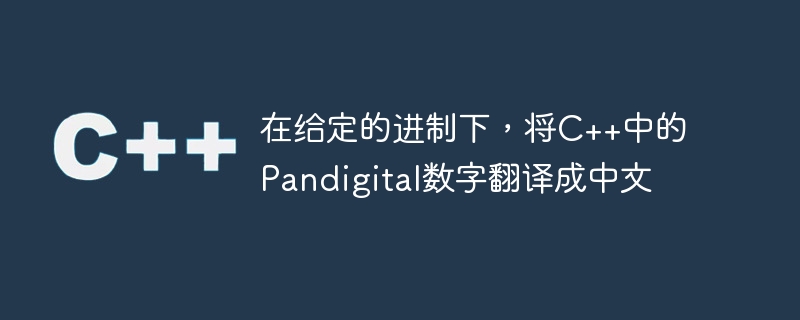在給定的進制下,將C++中的Pandigital數字翻譯成中文
- WBOYWBOYWBOYWBOYWBOYWBOYWBOYWBOYWBOYWBOYWBOYWBOYWB轉載
- 2023-08-30 08:01:101275瀏覽

包含從0到基數B的所有數字的數字稱為該基數下的全數字數。然而,有些數字的數字從1到9,被稱為無零全數字數。一些全數字數的例子包括0123456789,0789564312等。
在本教程中,我們將討論一個問題,我們給定一個數字和一個基數,我們需要檢查該數字在給定基數下是否為全數字數,例如−
Input: num = “9651723467380AZ”, base = 10 Output: YES Explanation: num contains all the digits in the base 10 i.e from 0 to 9, so it is a pandigital number. Input: num = “130264ABCDE745789”, base = 16 Output: NO Explanation: num does not contain F(15) which is in the base 16 i.e from 0 to 15, so it is not a pandigital number.
Approach to Find the Solution
To solve this problem, we will use Set and insert each digit in the set because we need to store unique values.
Traverse through the string, taking each character at a time.
Then check if the element is an integer or alphabet.
If it is an alphabet , then add 10 to its position on the alphabet to represent 2-digit.
Store the values in the set.
After traversing, check whether the size of the set equals to base.
#Example
C Code for the Above Approach
#
#include<bits/stdc++.h>
using namespace std;
int main(){
int base = 10;
char n[] = "9651723467380AZ";
// Declaring set to store unique values.
set<int, greater<int> > s;
// Traversing through the string.
for (int i = 0; i < strlen(n); i++){
// Checking if element is Integer.
if (n[i] >= '0' && n[i] <= '9')
s.insert(n[i]- '0');
// Checking if element is alphabet.
else if (n[i] - 'A' <= base - 11)
s.insert(n[i] - 'A' + 10) ;
}
// Checking if all the digits are present.
if(s.size()==base)
cout<< "YES";
else
cout<< "NO";
return 0;
}#輸出
YES
結論
在本教程中,我們討論了一個問題,即給定一個數字和基數。我們需要找出該數字是否為全數的。我們討論了一種簡單的方法來解決這個問題,即透過將值插入到一個集合中,並檢查其與基數的大小。我們也討論了這個問題的C 程序,我們可以使用類似C、Java、Python等程式語言來完成。希望您會發現這個教學有幫助。
以上是在給定的進制下,將C++中的Pandigital數字翻譯成中文的詳細內容。更多資訊請關注PHP中文網其他相關文章!

